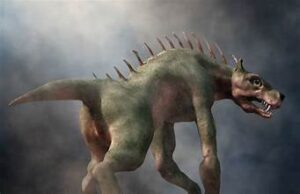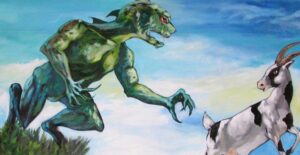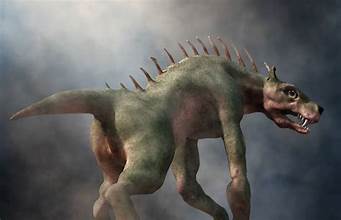
In the realm of cryptozoology, few creatures evoke as much mystery and fear as the Chupacabra. Known as the “goat-sucker,” this elusive beast is often blamed for strange animal deaths, especially in rural parts of Latin America. As sightings continue into 2024, the fascination with the Chupacabra shows no signs of fading. But what is the true origin of this blood-sucking creature? Is it a product of ancient folklore, a misunderstood animal, or something more sinister? This article dives deep into the myths surrounding the Chupacabra, exploring its origins, theories, and modern significance.
The First Sightings: How It All Began
The legend of the Chupacabra is relatively modern compared to ancient myths. The first widely reported sightings occurred in the 1990s in Puerto Rico, when livestock owners found dead animals with puncture wounds and reportedly drained of blood. Many residents believed these deaths were the work of a strange, vampiric creature stalking their lands at night.
The term “Chupacabra” comes from the Spanish words “chupar” (to suck) and “cabra” (goat), referring to its supposed blood-draining behavior. From Puerto Rico, the legend spread across Latin America and even into parts of the United States, with similar reports of livestock killings appearing from Mexico to Texas.
But is the Chupacabra a creature of modern myth, or does it have older roots?
Folklore Influences: Is Chupacabra an Ancient Myth Reborn?
While the specific term “Chupacabra” only emerged in the late 20th century, scholars suggest that the creature’s characteristics may have been influenced by much older folklore. Blood-drinking entities and night-dwelling beasts have long been a part of many cultures.
In Mesoamerican mythology, for example, the ancient Aztecs spoke of Camazotz, a bat-like god associated with death and the underworld. Similarly, stories from Caribbean cultures often feature bloodthirsty creatures that attack animals and humans alike. Could these ancient legends have evolved into the modern Chupacabra myth?
Theories abound, with some suggesting that the fear of the Chupacabra taps into primal fears of predation and disease. However, despite these possible influences, there are no direct mentions of a “goat-sucking” creature in indigenous or colonial Latin American folklore, suggesting that the Chupacabra may indeed be a contemporary invention.
Modern Interpretations: Alien Encounters or Genetic Mutations?
The rise of the Chupacabra legend coincided with a wave of UFO sightings and alien abduction stories in the 1990s. Some believers argue that the Chupacabra could be an extraterrestrial being, sent to Earth as part of a larger invasion or experiment. These theories gained traction as some eyewitnesses described the creature as having glowing red eyes, reptilian skin, and spines down its back—characteristics often associated with depictions of aliens.
In addition to extraterrestrial theories, some have suggested that the Chupacabra could be the result of government genetic experiments gone wrong. This theory postulates that a lab-created creature may have escaped from a secret facility, leading to the livestock killings. However, no credible evidence has ever surfaced to support this idea.
Others believe that the Chupacabra is a misidentified animal, with dogs, coyotes, or even large bats being blamed for the attacks. In several cases where supposed Chupacabra carcasses were found, DNA tests later confirmed that the creatures were in fact suffering from diseases such as mange, which can cause significant hair loss and a gaunt, unnatural appearance.
Scientific Explanations: The Truth Behind the Myth
Despite the fantastic stories surrounding the Chupacabra, most scientists remain skeptical of its existence. Zoologists and wildlife experts argue that the strange deaths attributed to the creature are likely the result of common predators or natural causes.
One scientific explanation for the supposed “blood-draining” deaths is myiasis, a parasitic infection where flies lay eggs in open wounds. The resulting maggots can feed on the tissue, giving the appearance that the animal was attacked by a predator. Additionally, scavengers may feed on the bodies after the animals have died, creating puncture wounds that are later mistaken for bites from a mysterious beast.
Similarly, many of the animals claimed to be Chupacabras are often diseased or deformed canines. When suffering from severe mange, coyotes, dogs, and foxes lose large amounts of fur, giving them an eerie, alien-like appearance. These animals may also behave unusually, venturing into human territory in search of food, which leads to them being mistaken for cryptids.
The Role of Media and Pop Culture
One cannot underestimate the role that media has played in perpetuating the Chupacabra myth. After the initial reports from Puerto Rico, the creature quickly gained international attention through news outlets, radio shows, and later, the internet. As stories spread, they became more exaggerated, with Chupacabra taking on new forms and behaviors depending on the region.
In the United States, for example, the creature is often described as a hairless, dog-like beast, while in Latin America, it is more commonly depicted as a bipedal, reptilian entity with spikes along its back. These regional variations highlight how myths evolve over time, influenced by local culture and media representations.
The Chupacabra has also become a fixture in pop culture, appearing in television shows, movies, books, and video games. Shows like The X-Files and Supernatural have featured episodes centered around the beast, while documentaries and mockumentaries explore its existence. This media attention has only fueled public interest in the legend, keeping the myth alive well into the 21st century.
Chupacabra Sightings in 2024: Are They Still Occurring?
In 2024, reports of Chupacabra sightings and livestock attacks continue, particularly in rural areas of Latin America and the southern United States. However, these reports are fewer and less sensationalized than those from the 1990s. Advances in technology, particularly DNA testing, have made it easier to debunk supposed Chupacabra encounters, often identifying the “creature” as a coyote or dog with a skin disease.
Nevertheless, the Chupacabra remains a popular topic among cryptozoologists and paranormal enthusiasts. Online forums and social media are filled with new eyewitness accounts, theories, and purported evidence of the creature’s existence. The persistence of the myth suggests that the Chupacabra taps into deep-seated fears and cultural anxieties that continue to resonate with people today.
Conclusion: Myth, Monster, or Misidentification?
As we unravel the origins of the Chupacabra, it becomes clear that the creature is a blend of modern myth, ancient folklore, and misidentification. While no definitive evidence has ever confirmed the existence of a blood-sucking beast, the Chupacabra lives on in popular culture and the imaginations of those who seek to explain the unexplainable.


















